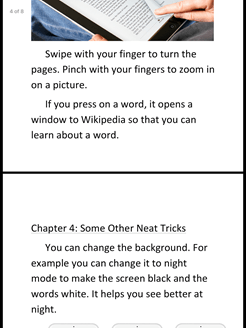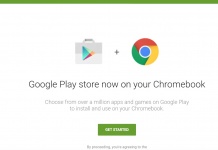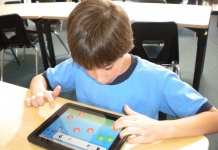 With my Grade 3/4 class halved due to a flu bug, it seemed like a peaceful week to wrap up our little e-book unit. For our final project, we made a little e-book of our own to share our learning with the children’s parents.
With my Grade 3/4 class halved due to a flu bug, it seemed like a peaceful week to wrap up our little e-book unit. For our final project, we made a little e-book of our own to share our learning with the children’s parents.
I was delighted by how insightful some of students’ comments were. When one child rhapsodized about how much the kids loved to read e-books at school, another pointed out that we should talk about the disadvantages, too. The big negative mentioned was the money side; the children were very concerned that devices would be too expensive for most people to replace if they got damaged or broken. In a school with 15 iPads and about 100 kids, they also worried that access to books might be restricted for kids whose schools could not afford to buy one device per student.
With only a little prompting, the children readily condensed the high points. Night mode, white letters against a dark background to reduce glare or read more comfortably at night, had been a big hit with them. They explained it in their own words with little difficulty. The students also explained the benefit of font adjustment: if you have trouble seeing small words, you can make them big, and ‘your problem is solved.’
No, this will not be the last time I work with kids and e-books. Hardly! The students’ enthusiasm for the medium is clear—I’ve shown it is in fact possible to engage them, just as educators traditionally strive to do in the case of paper books. Yes, paper has its advantages such as a tactile experience. But then it’s so easy for a teacher to help the kids make their own mini e-books on any topic, and along the way, we could sharpen the children’s reading and research skills, not just their writing ones.
The project I undertook with the students was not ambitious. But think about one where they needed to do truly extensive research, at least extensive by third- or fourth-grade standards. And then consider the pride the parents could take in the finished products, the actual books, regardless of whether they were just minis. Whether or not the parents owned tablets or dedicated e-readers, they could still download the PDFs onto family desktops. Teachers and librarians could show them how if they didn’t know. What’s more, as e-book creation software improves, it should be easier to serve up ePub versions easily readable on cell phones (some existing creation tools are mentioned here).
Ideally teacher-librarian collaborations could happen. The teachers would assign the work and guide the kids along on production matters, and meanwhile librarians should show them research techniques and point them to useful materials.
On top of that, the prices of e-book-capable devices will be coming down. Here in Canada, we don’t have the $35USD Kindle yet. But it’s only a matter of time.
Rather than badmouthing the tech, educators need to focus on ways teaching it properly—so that, for example, kids know how to use the ‘search’ function properly to keep up with characters in novels or more quickly find information in nonfiction books, including those their classmates may write.
The Little E-Book Project: The Actual text
For privacy reasons, I can’t share the whole PDF with you, as it contains student names and other information. But minus just about all the photos, as well as the formatting, here is the Little E-Book Project. It was written, over two periods, by three 8-year-old students.
How to Use an e-book
By [Student Names]
Chapter 1: What is an e-book?
An e-book is a book that is on a device such as a computer, an iPad, a phone or an e-book device.
They are good to use because you can get a new book right away, no matter where you are.
Also, there are unlimited copies because it is digital. The bookstore will never run out of copies.
Chapter 2: Where to get e-books
Some e-books are free. For example, you can get free eBooks at Project Gutenberg. You can buy eBooks at Indigo using the Kobo app, at Amazon using the Kindle app or at Apple using the iBooks app.
Chapter 3: How to use them
First, you open the app. Then, you press on the cover. That opens the book.
Swipe with your finger to turn the pages. Pinch with your fingers to zoom in on a picture.
If you press on a word, it opens a window to Wikipedia so that you can learn about a word.
Chapter 4: Some other neat tricks
You can change the background. For example you can change it to night mode to make the screen black and the words white. It helps you see better at night.
You can change the words and make them bigger or smaller. If you have trouble seeing small words, you can make them big and your problem is solved. You can adjust the screen brightness too.
Chapter 5: Disadvantages of an e-book
If you lose your device, you cannot read your books until you get a new one, and that is very expensive!
Also, if you cannot afford to buy a device, you cannot read eBooks, you have to read paper books.
If you drop your device, it can break. But books cannot break.

Chapter 6: Some Books to Try
The Night Before Christmas is awesome, and we got it for free at Project Gutenberg. We read it at school during Technology time.
Here are some e-books we found at the Kindle store.
1) Spongebob Junior Novel for $4.70
2) House at Pooh Corner for $16.42
3) The Ugly Duckling for Free!
4) Chicks! For $3.45
5) Inside Out Junior Novel for $3.36
THE END!

































